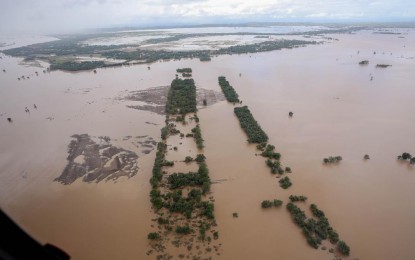
MASSIVE FLOOD. Aerial file photo shows the aftermath of the massive flood caused by Typhoon Ulysses in Cagayan Valley in November 2020. The House of Representatives’ Special Technical Working Group committee is seeking ways to prevent a repeat of the massive flooding through sustainable programs. (Presidential photo by Ace Morandante)
TUGUEGARAO CITY – The House of Representatives’ Special Technical Working Group (TWG) committee is advocating for projects and programs to prevent a repeat of the massive flooding experienced in Cagayan Valley, Cordillera and Ilocos regions last year.
"We hope to end the flooding through sustainable and long-term funding in an effort to have funds for sustainable and long-term projects due to the magnitude of the Typhoon Ulysses last year,” Cagayan Rep. Joseph Lara, TWG chairperson, told the Philippine News Agency on Sunday.
The TWG, which conducted a public hearing at the Pulsar Hotel in this city, had earlier initiated an investigation to address issues related to the massive flooding in Luzon from Nov. 11-12, 2020.
“It does not matter if the funding will be a 10-year or 20-year budget. As long as we can address the problems and spend funds for 'urgently needed' anti-flood projects to prevent soil erosions, among others,” Lara said.
The committee members had earlier tried to conduct an aerial inspection of the flood-affected area but it was stalled by rainy weather in the past days. Previous footages were used instead as they took a land trip to Magat Dam in Isabela to personally assess the area.
Lara said they would finalize the outcome of the hearing as “the committee is identifying needed infrastructure projects and government intervention programs to prevent a similar disaster from happening again.”
“The House is serious. We came out with proposals and what are the problems emanating from the massive flooding must be addressed with funding to be entailed,” he said, adding that it did not beat the budget hearing because of the delays caused by the coronavirus disease crisis.
He noted that the discharge of water from the Magat Dam during the onslaught of Typhoon Ulysses was only one of the factors that caused the flooding in Cagayan and Isabela.
The committee identified other factors as the excessive and continuous rain which caused saturation of soil in large areas, massive siltation of the Cagayan River basin, denuded mountains in the watershed areas as a result of illegal logging, mining and quarrying, and soil erosion due to deforestation.
National Irrigation Administration acting division manager Carlo Ablan said during the hearing that an updated protocol system on dam management, Cagayan River basin and tributary rehabilitation plan, and replication of the plan in other river basin areas with similar flooding problems to prevent similar disasters, have been proposed.
Members from the Office of the Civil Defense, National Disaster Risk Reduction and Management Council, Philippine Atmospheric, Geophysical and Astronomical Services Administration, and National Water Resources Board have also proposed structural and vegetative measures to ease water flow in the Cagayan river such as the removal and dredging of sandbars, desilting of Magat Dam, construction of riverbank protection structures; channel widening and realignment; opening of secondary channels; and construction of dams, dikes, and small water impounding projects.
Establishment of buffer zones such as tree lanes and vegetation shields, further strengthening of the National Greening Program, and promotion of agroforestry and sloping agricultural land technology to control soil erosion were likewise mentioned. (PNA)
